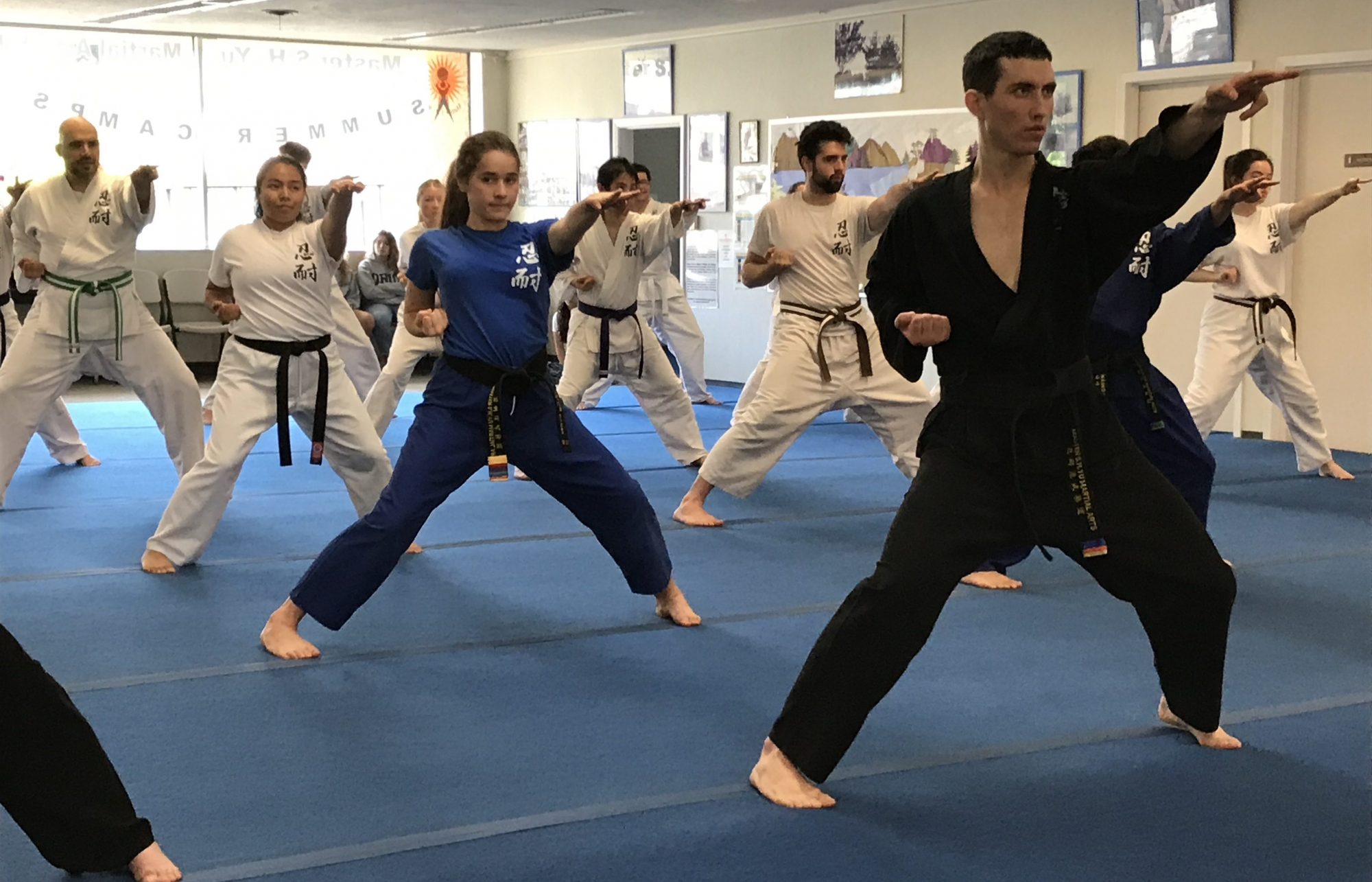As an Amazon Associate, I earn from qualifying purchases.
Muay Thai (Kickboxing) is considered one of the easiest martial arts to learn, making it a great choice for beginners. Focusing on knee strikes, punches, and kicks, Muay Thai provides a solid foundation for self-defense training.
Additionally, Muay Thai’s clinch technique can be beneficial for judo and wrestling enthusiasts. As a beginner-friendly martial art, Muay Thai offers a practical and engaging starting point for those looking to explore the world of martial arts. Its emphasis on striking techniques and physical conditioning makes it accessible to individuals of various fitness levels and ages, making it a popular choice for those seeking an effective and relatively straightforward martial art to learn.
Introduction To Martial Arts For Beginners
Discover the easiest martial art for beginners – Muay Thai. This dynamic form focuses on knee strikes, punches, and kicks, making it a great starting point for those new to martial arts. Master the clinch technique and build a solid foundation for your journey into the world of combat sports.
Benefits Of Learning Martial Arts
When it comes to the world of martial arts, there are numerous benefits that beginners can enjoy. From physical fitness to mental discipline, martial arts offer a holistic approach to self-improvement.
- Physical Fitness: Martial arts training involves rigorous physical activity, which helps in improving strength, flexibility, and endurance.
- Self-Defense: Learning martial arts equips beginners with essential self-defense techniques, boosting their confidence and sense of security.
- Mental Discipline: Martial arts emphasize mental focus, self-control, and perseverance, nurturing a disciplined mindset.
- Stress Relief: Engaging in martial arts can serve as an effective stress reliever, promoting mental well-being.
Criteria For Evaluating Ease Of Learning
When evaluating the ease of learning a martial art, several criteria come into play. These factors can greatly influence the beginner’s ability to grasp the techniques and concepts efficiently.
- Complexity of Techniques: The simplicity and practicality of techniques can impact the ease of learning for beginners.
- Physical Demands: The physical requirements and conditioning needed for a particular martial art can affect its ease of learning.
- Teaching Methodology: The teaching style and approach of the instructor or training program can significantly impact the learning experience for beginners.
- Adaptability: Martial arts that are adaptable to diverse body types and fitness levels tend to be more beginner-friendly.
Boxing: The Basics
Fundamentals Of Boxing Technique
Boxing technique involves footwork, stance, and striking with fists.
Solo Training Drills For Beginners
Beginners can practice shadowboxing, footwork drills, and heavy bag workouts.
Judo: The Gentle Way
Judo, often referred to as “The Gentle Way,” is a martial art that focuses on using an opponent’s energy against them, making it an ideal choice for those seeking a practical and effective self-defense technique.
Core Principles Of Judo
Judo is based on the principle of maximum efficiency with minimal effort, emphasizing the use of an opponent’s strength and momentum to gain the upper hand. It promotes the concept of “gentleness” or “yielding” to overcome an adversary, making it suitable for individuals of all ages and physical abilities.
Essential Judo Techniques For Self-defense
Key techniques in judo include throws, takedowns, joint locks, and pins, which are designed to neutralize an attacker without causing excessive harm. These techniques can be adapted for real-life self-defense situations, providing individuals with the skills needed to protect themselves in a variety of encounters.

Credit: ellismartialarts.com
Muay Thai: The Art Of Eight Limbs
Muay Thai, known as the Art of Eight Limbs, is considered one of the easiest martial arts to learn for beginners. Focusing on striking techniques like knee strikes, punches, and kicks, Muay Thai provides a great foundation for those starting out in martial arts.
Muay Thai: The Art of Eight Limbs is a martial art that originated in Thailand and has gained popularity worldwide due to its effectiveness in self-defense, fitness benefits, and striking techniques. Unlike other martial arts that focus on punches and kicks, Muay Thai emphasizes the use of eight limbs – fists, elbows, knees, and shins, making it one of the most lethal martial arts. If you’re looking for an easy-to-learn martial art that can help you defend yourself, Muay Thai is a great option. Here are some key Muay Thai moves for quick mastery and training routines to enhance your skills.Key Muay Thai Moves For Quick Mastery
Muay Thai involves a wide variety of striking techniques, but some moves are more essential than others. Here are some of the key moves that you should focus on to master Muay Thai quickly.- Jab: A quick and straight punch thrown with your lead hand
- Cross: A powerful punch thrown with your rear hand
- Front kick: A kick delivered using your lead leg, targeting the opponent’s torso or legs
- Roundhouse kick: A kick delivered using your rear leg, targeting the opponent’s torso or legs
- Elbow strikes: Short-range strikes delivered using your elbow, targeting the opponent’s head, face, or body
- Knee strikes: Strikes delivered using your knee, targeting the opponent’s body or head
Training Routines To Enhance Skills
To master Muay Thai, you need to train regularly and consistently. Here are some training routines that can help you enhance your skills:- Shadowboxing: Practice your moves in front of a mirror without a partner, focusing on your technique and footwork
- Pad work: Train with a partner holding pads to practice your strikes and combinations
- Heavy bag: Practice your power and endurance by hitting a heavy bag with your fists, elbows, knees, and shins
- Sparring: Test your skills against a partner in a controlled environment to simulate real fighting situations
- Conditioning: Improve your fitness and endurance through strength and conditioning exercises such as running, jumping, and weightlifting
Brazilian Jiu-jitsu: Ground Control
Brazilian Jiu-Jitsu stands out as the easiest martial art to learn, emphasizing ground control and leverage over strength. Its techniques focus on grappling and submission holds, making it accessible for beginners to develop self-defense skills effectively.
Bjj Techniques Effective For Beginners
Brazilian Jiu-Jitsu is a martial art that focuses on ground fighting techniques and is considered one of the easiest martial arts to learn for beginners. BJJ emphasizes leverage and technique over brute strength and size, making it an excellent option for anyone looking to learn self-defense. One of the most effective BJJ techniques for beginners is the guard. The guard is a position where you are on your back with your legs wrapped around your opponent’s waist. From this position, you can control your opponent’s movements and look for opportunities to submit them with chokes or joint locks.Building A Foundation In Bjj At Home
If you want to start learning BJJ but don’t have access to a gym or a training partner, there are still ways to build a solid foundation in the art. One of the best ways to do this is by studying instructional videos and practicing the techniques on your own. There are many BJJ instructional videos available online that cover everything from basic techniques to advanced strategies. By studying these videos and practicing the techniques on your own, you can develop a strong understanding of the fundamentals of BJJ and build a solid foundation for future training. In conclusion, Brazilian Jiu-Jitsu is an excellent martial art for beginners to learn, particularly those who are interested in self-defense. The guard position and other BJJ techniques are highly effective, and with the right instruction, it’s possible to build a strong foundation in the art even without access to a gym or training partner. Whether you’re interested in competing or just want to learn a new skill, BJJ is definitely worth checking out.
Credit: sparkmembership.com
Krav Maga: Reality-based Protection
When it comes to self-defense and reality-based protection, Krav Maga stands out as one of the most effective martial arts. Developed in Israel, Krav Maga is known for its practical and efficient techniques that are designed to neutralize threats quickly and decisively. Unlike traditional martial arts that focus on form and tradition, Krav Maga is all about real-world application and instinctive movements.
Krav Maga’s Approach To Threat Neutralization
Krav Maga emphasizes quick and aggressive counterattacks to neutralize threats as efficiently as possible. Its techniques are based on natural body movements and instinctive reactions, making it easier for novices to learn and apply in high-stress situations. The primary goal of Krav Maga is to end a confrontation as swiftly as possible, using strikes to vulnerable targets and taking advantage of an opponent’s weaknesses.
Simple Krav Maga Drills For Novices
For beginners, Krav Maga offers simple yet effective drills to develop essential self-defense skills. These drills focus on fundamental techniques such as striking, blocking, and defending against common attacks. By practicing these drills, novices can build muscle memory and gain confidence in their ability to respond to threats effectively.
Aikido: The Way Of Harmony
Aikido, a Japanese martial art, focuses on using an opponent’s energy to gain control. It emphasizes blending with the attacker rather than opposing their force.
Aikido Techniques Suited For Starters
Aikido techniques suitable for beginners include basic throws, joint locks, and pins. These techniques emphasize redirection of energy and minimal physical strength.
Practicing Aikido’s Fluid Movements Solo
Practicing Aikido’s fluid movements solo allows beginners to improve balance, coordination, and timing. Solo practice helps in mastering the fundamental movements of Aikido.
Achieving Proficiency: The Black Belt Journey
Embarking on the black belt journey in martial arts is a challenging yet rewarding endeavor. For those seeking the easiest martial art to learn, Muay Thai, known for its emphasis on striking and clinching techniques, is considered a great starting point.
With its focus on knee strikes, punches, and kicks, Muay Thai offers a practical and accessible entry into the world of martial arts.
Quickest Paths To A Black Belt
When it comes to achieving a black belt in martial arts, some disciplines offer quicker paths than others. Typically, karate and taekwondo are known for their streamlined black belt journey. These disciplines often have a clear and structured belt system, with well-defined requirements for advancing through the ranks. On the other hand, disciplines like jiu-jitsu and judo may have a more rigorous and time-intensive path to achieving a black belt.
For those seeking a fast-track route to black belt proficiency, karate and taekwondo may be the ideal choices. However, it’s essential to keep in mind that the speed of progression should not compromise the quality and depth of training.
Long-term Commitment Vs. Short-term Goals
When embarking on the journey towards a black belt, individuals often face the decision between long-term commitment and short-term goals. Some may opt for disciplines that offer a relatively swift path to black belt attainment, aiming for a short-term achievement. Conversely, others may prioritize a long-term commitment to a discipline that aligns with their personal values and aspirations.
While short-term goals can provide a sense of accomplishment, long-term commitment fosters a deeper understanding and mastery of the martial art. It is important to carefully consider individual preferences and objectives when choosing a martial art, ensuring that the chosen path resonates with both short-term aspirations and long-term dedication.
Self-teaching Martial Arts
Self-teaching martial arts can be an empowering and rewarding journey, offering individuals the opportunity to develop physical fitness, mental discipline, and self-defense skills at their own pace. It’s natural to wonder about the feasibility of learning martial arts alone, especially with the abundance of resources and tools available today.
Can You Learn Martial Arts Alone?
Learning martial arts alone is indeed possible, particularly with the right discipline, dedication, and guidance. While traditional martial arts training often involves in-person instruction and partner practice, there are various martial arts that lend themselves well to self-teaching. With the aid of online tutorials, instructional books, and instructional videos, individuals can start their martial arts journey independently.
Resources And Tools For Solo Learners
For those venturing into self-teaching martial arts, there is a wealth of resources and tools available to facilitate learning. Online platforms offer a plethora of instructional content, including step-by-step tutorials, training tips, and demonstrations. Additionally, instructional books and DVDs can serve as valuable references for solo learners, providing detailed insights into techniques and training regimens.
Conclusion: Choosing The Right Martial Art
If you’re looking for the easiest martial art to learn, consider your personal interests and physical abilities. Boxing, Muay Thai, and Brazilian Jiu-Jitsu are popular choices for beginners due to their practical techniques and accessible learning curve. Ultimately, the right martial art for you is the one that aligns with your goals and feels enjoyable to practice.
Balancing Ease And Effectiveness
When choosing a martial art, it’s crucial to find a balance between ease of learning and effectiveness in real-life situations. Consider your goals, physical abilities, and the practicality of the techniques.
Next Steps After Picking A Martial Art
After selecting a martial art, the next steps involve consistent practice, setting achievable goals, and seeking guidance from experienced instructors. Remember that mastery comes with dedication and perseverance.

Credit: www.master-sh-yu.com
Frequently Asked Questions
What Is The Easiest Martial Art To Learn On Your Own?
Muay Thai (Kickboxing) is one of the easiest martial arts to learn on your own. It focuses on knee strikes, punches, and kicks, making it beginner-friendly.
What Is A Beginner Martial Art?
Muay Thai is a great beginner martial art, focusing on strikes, kicks, and clinching techniques.
What Is The Easiest Martial Art To Get A Black Belt?
Muay Thai is often considered the easiest martial art to learn and a great starting point for beginners. It focuses on knee strikes, punches, and kicks, which are integral techniques. It also emphasizes the clinch technique, useful for judo and wrestling.
However, it’s important to note that the time it takes to earn a black belt may vary depending on the individual’s dedication and skill level.
Is There A Martial Art You Can Learn Alone?
Boxing is a martial art that can be self-taught. Basic boxing techniques can be practiced alone without the need for a partner. However, it’s important to note that learning any martial art alone can be challenging as having a teacher and training partners can greatly improve your technique and progress.
Conclusion
Muay Thai is a great starting point for beginners due to its focus on clinch techniques, knee strikes, punches, and kicks. Boxing, Muay Thai, and Brazilian Jiu-Jitsu are also beginner-friendly martial arts. Remember, the best martial art for you depends on your goals and comfort level.
Choose wisely and enjoy your martial arts journey!
As an Amazon Associate, I earn from qualifying purchases.
